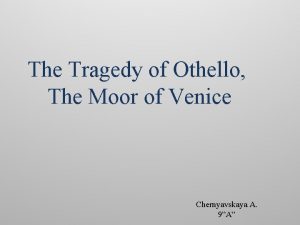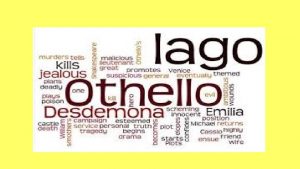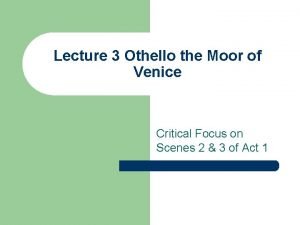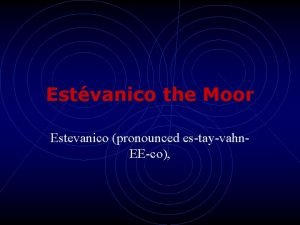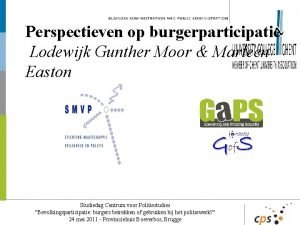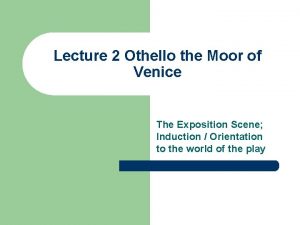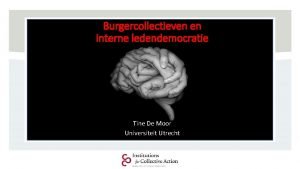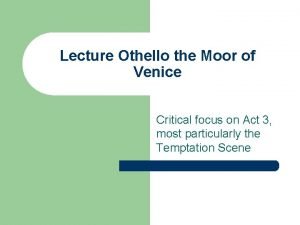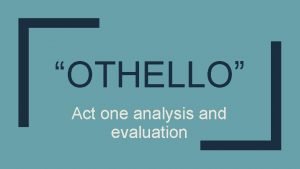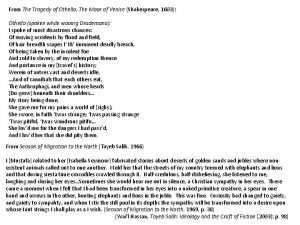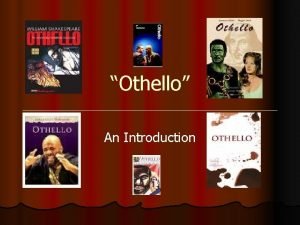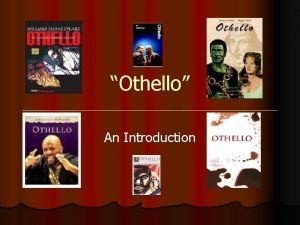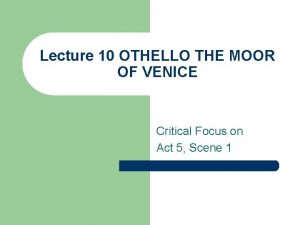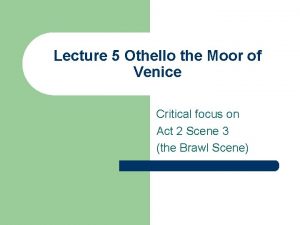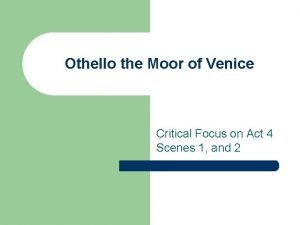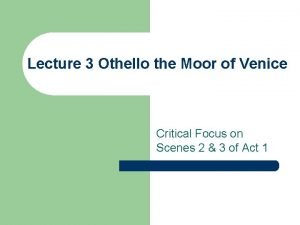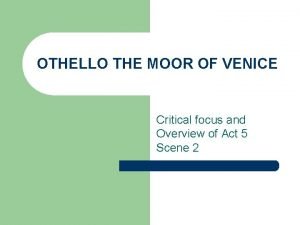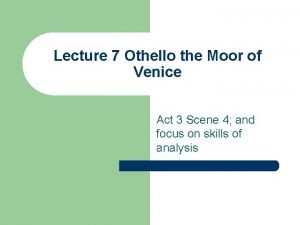OTHELLO OR THE TRAGEDY OF OTHELLO THE MOOR




































- Slides: 36

OTHELLO -OR- THE TRAGEDY OF OTHELLO, THE MOOR OF VENICE CONTEXT AND THINGS TO THINK OVER

WILLIAM SHAKESPEARE


STRATFORD-UPON-AVON & LONDON, ENGLAND ★

ANNE HATHAWAY

ELIZABETHAN ENGLAND

QUEEN ELIZABETH I TO KING JAMES VI

ELIZABETHAN ENGLAND, CONT.

GLOBE THEATRE

GLOBE THEATRE, CONT.

LONDON TO VENICE & CYPRUS ★ ★ ★

OTHER RACES IN ELIZABETHAN ENGLAND?

WHAT IS A TRAGIC HERO? • It’s an archetype: original pattern or model to represent universal symbols or patterns of human nature (of characters, themes, symbols, situations, etc. ) • Classical definition (dating back to the ancient Greeks) usually involves noble birth, fate, and/or the wishes of the gods. • In the past, almost ALWAYS a man. Now, it can be anyone.

ASPECTS OF A TRAGIC HERO • Esteemed/admirable/noble person with heroic/potentially heroic qualities: the tragic hero has to “fall” from some sort of lofty position

ASPECTS OF A TRAGIC HERO • Often that lofty position is tied to some sort of call for “adventure”-- perhaps saving the world.

ASPECTS OF A TRAGIC HERO • Hamartia (a tragic flaw): the hero must fall due to some flaw in his own personality. The most common hamartia is hubris (excessive pride/overconfidence, especially in the face of fate).

ASPECTS OF A TRAGIC HERO • Fate & Free Choice: fate will always play a role to a certain degree, but there also MUST be an element of choice when it comes to the fall of the tragic hero. This is where a lot of the tragedy comes in; the hero falls because he picked one course of action over another.

ASPECTS OF A TRAGIC HERO • The punishment exceeds the crime: the audience doesn’t feel the hero gets what he deserves for making that bad choice; part of the tragedy is the injustice of the punishment.

ASPECTS OF A TRAGIC HERO • Epiphany: the hero realizes/understands what went wrong or understands/discovers something that wasn’t clear before the fall; he realizes this just before his tragic end.

ASPECTS OF A TRAGIC HERO • Catharsis (a release or purging of feelings): the audience feels emotionally drained, yet somehow still exultant at the end.

CENTRAL IDEAS/THINGS TO TRACE AS WE GO: • Dynamic of Individual vs. Society

CENTRAL IDEAS/THINGS TO TRACE AS WE GO: • Consequences of Choice/Causality vs Fate/Destiny

CENTRAL IDEAS/THINGS TO TRACE AS WE GO: • Appearance vs. Reality • Pretense vs. Honesty

CENTRAL IDEAS/THINGS TO TRACE AS WE GO: • Balance of Masculine vs. Feminine Values

CENTRAL IDEAS/THINGS TO TRACE AS WE GO: • Revenge vs. Justice

CENTRAL IDEAS/THINGS TO TRACE AS WE GO: • The Nature of Corruption

CENTRAL IDEAS/THINGS TO TRACE AS WE GO: • Balance of Loyalty/Love vs. Betrayal/Self-Interest

SOME THINGS TO TRACE AS WE GO: • Animal Motif Implications • Light and Dark /Contrasts • Symbols • Similes/Metaphors/Personification

BUT ABOVE ALL, THINK ABOUT… How is characterization used to develop these strands?

A REVIEW Indirect: The character’s… -Actions/Reactions -Speech -Thoughts -Appearance -Way of being perceived by others Direct: -What the author says about the character (which would be rare in a play– especially Shakespeare’s plays, which rarely have much stage direction)

CHARACTERS TO FOCUS ON WHILE READING • Othello • Iago • Desdemona • • HOW DO THEY DEVELOP? Cassio Emilia Roderigo Barbantio

QUESTIONS ABOUT CHARACTERS: Who is the protagonist? Who or what is the antagonist? Are there any foils?

AS WE GO… Plot points, Implications of changes in what you’re character that reading, change feel important in plot/characters (so what? ) (present tense)

AS WE GO You’ll also be working on your Othello handout.

SAVIO’S RULES OF SHAKESPEARE 1) Shakespeare was a genius and he is considered one of the greatest writers in the history of storytelling. He was incredibly smart, and no one wants to have to be as smart as Shakespeare. Therefore, we accept that we will not understand every single thing we read in his plays, but we will be able to understand more than enough to appreciate what he’s written, see what central ideas he’s conveying, and be able to discuss the text for eight minutes.

SAVIO’S RULES OF SHAKESPEARE 2) Shakespeare wrote about 500 years ago, so we will make mistakes pronouncing some of the words he put in his plays (and that’s OK!).
 The tragedy of othello the moor of venice
The tragedy of othello the moor of venice Tragic hero othello
Tragic hero othello Definition of shakespearean tragedy
Definition of shakespearean tragedy Origin of greek drama
Origin of greek drama Shakespearean tragedy definition
Shakespearean tragedy definition Summary act 1 othello
Summary act 1 othello The moor is of a free and open nature
The moor is of a free and open nature Andrus moor
Andrus moor Chafford pharmacy inc
Chafford pharmacy inc Othello act one scene one annotations
Othello act one scene one annotations Estevanico the moor
Estevanico the moor Marleen de moor
Marleen de moor Laurent moor
Laurent moor Othello summary
Othello summary Cutting edge peter moor
Cutting edge peter moor Othello act 2 summary
Othello act 2 summary Bart de moor
Bart de moor Tine de moor
Tine de moor The moor already changes with my poison
The moor already changes with my poison Othello foreshadowing
Othello foreshadowing Racism in othello act 4
Racism in othello act 4 Saint james the moor slayer
Saint james the moor slayer Abc language programming
Abc language programming Marleen de moor
Marleen de moor Heaton.moor medical centre
Heaton.moor medical centre Degree of lewdity moor
Degree of lewdity moor Thể thơ truyền thống
Thể thơ truyền thống Cái miệng xinh xinh thế chỉ nói điều hay thôi
Cái miệng xinh xinh thế chỉ nói điều hay thôi Các châu lục và đại dương trên thế giới
Các châu lục và đại dương trên thế giới Từ ngữ thể hiện lòng nhân hậu
Từ ngữ thể hiện lòng nhân hậu Diễn thế sinh thái là
Diễn thế sinh thái là V. c c
V. c c Làm thế nào để 102-1=99
Làm thế nào để 102-1=99 Tỉ lệ cơ thể trẻ em
Tỉ lệ cơ thể trẻ em Chúa sống lại
Chúa sống lại Khi nào hổ mẹ dạy hổ con săn mồi
Khi nào hổ mẹ dạy hổ con săn mồi đại từ thay thế
đại từ thay thế
